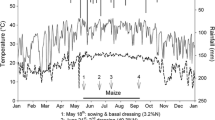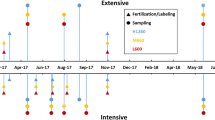Abstract
Improved cropping systems with in-situ production of organic matter require the input of additional inorganic N to maintain crop production in a sustainable way. For proper management of this fertilizer-N, it is necessary to quantify how the applied fertilizer N is used by the various components of the system and by the system as a whole. The fate of a single application of 15N labeled urea-N through the different components (crop, hedgerow, surface litter, soil profile up to 150 cm) of a Senna siamea alley cropping system, intercropped with maize in the first and cowpea in the second season, was followed for a period of 1.5 years (1994–1995), equivalent to 2 maize and 1 cowpea crop. Special attention was given to the role of the particulate organic matter (POM) in the cycling of urea-N through the soil organic matter (SOM). The maize crop recovered 26.5 and 1.7% of the applied urea-N at harvest in 1994 and 1995, respectively. The cowpea pods recovered only 0.7% of the applied urea-N at harvest. The highest proportion of applied urea-N recovered by the hedgerow occurred at 38 days after 1994 maize planting (DAP) (3.8%), while at later dates, recoveries of applied urea-N were always below 1%. This indicates that the Senna hedge is not a strong competitor for the applied urea-N during crop growth, i.e. while the Senna canopy is pruned at regular intervals. At 21 DAP, 12.7% of the applied urea-N was recovered in the surface litter and this value dropped significantly to 1.6% at 107 DAP and remained below 1% up to 480 DAP. The top 10 cm of soil contained 21% of the applied urea-N at 21 DAP and this value dropped to 9% at 480 DAP. Significantly more urea-N was recovered in the top 10 cm of soil than in the deeper soil layers at all sampling times. At 21 DAP, 11% of the applied urea-N was recovered in the 120–150 cm layer. This fast movement of urea-derived N to deep soil layers must have happened by preferential flow in macropores as the rainfall between urea application and the first sampling (74.2 mm) was not high enough to explain downward movement of N with the mobile water. Significant linear relationships between the proportion of urea-N in the different soil layers (excluding 0–10 cm) and the anion exchange capacity (AEC) and silt+clay content of the respective layers were found at 67, 107, 347 and 480 DAP. The total N content of the POM fraction increased significantly between 0 and 101 DAP from 127 to 171 mg N kg−1 and decreased to 92 mg N kg−1 at 480 DAP. The highest recovery of applied urea-N in the POM pool was measured at 101 DAP (3.6%) and this value decreased to 1.8% at 480 DAP. The total recovery of applied urea-N was 81% at 21 DAP, and decreased to values varying between 53 and 60% up from 38 to 347 DAP. At 480 DAP, the recovery decreased further to 47%. The fast movement of a substantial amount of urea-N may be responsible for this incomplete recovery, already at 21 DAP. Although the soil N status in the fertilized alley cropping system appears to be favourable for plant growth, this may be short-lived in the absence of further urea additions, as the soil-derived maize uptake in 1995 was already significantly lower than in 1994, and as the labile POM pool decreased significantly between the maize harvest in 1994 and 1995.
Similar content being viewed by others
References
Aihou K, Sanginga N, Vanlauwe B, Lyasse O, Diels J and Merckx R 1999 Alley cropping in the moist savanna of West-Africa: I. Restoration and maintenance of soil fertility on ‘terre de barre’ soils in Bénin Republic.Agrof. Syst.42,213–227.
Arora Y and Juo A S R 1982 Leaching of fertilizer ions in a kaolinitic Ultisol in the high rainfall tropics: Leaching of nitrate in field plots under cropping and bare fallow.Soil Sc. Soc. Am. J. 46,1212–1218.
FAO 1991World Soil Resources: An Explanatory Note on the FAO World Soil Resources Map at 1:25 000 000 Scale.Food and Agriculture Organization of the United Nations, Rome, Italy. 58p.
Fernandez-Rivera S, Williams T O, Hiernaux P and Powell JM 1993 Faecal excretion by ruminants and manure availability for crop production in semi-arid West Africa. In Livestock and Sustainable Nutrient Cycling in Mixed Farming Systems of sub-Saharan Africa. Eds. JM Powell, S Fernandez-Rivera, RO Williams and C Renard. pp 149–170. International Livestock Centre for Africa, Addis Ababa, Ethiopia.
Haggar J P, Tanner E V J, Beer J W and Kass D C L 1993.Nitrogen dynamics of tropical agroforestry and annual cropping systems. Soil Biol. Biochem.25,1363–1378.
Hauser S 1993Root distribution of Dactyladenia (Acioa) barteri and Senna (Cassia) siamea in alley cropping on Ultisol. I. Implication for field experimentation.Agrof. Syst.24,111–121.
Hendershot W H, Lalande H and Duquette M 1993Ion exchange and exchangeable cations. In Soil Sampling and Methods of Analysis. Ed. MR Carter. pp 167–176. Canadian Society of Soil Science, Lewis Publishers, Boca Raton, US.
Houngnandan P 2000 Efficiency of the use of organic and inorganic nutrient sources in maize based cropping systems in the derived savanna of Benin.PhD thesis,Faculty of Agricultural and Applied Biological Sciences, University of Ghent, Ghent, Belgium.
Manyong V M, Makinde K O, Sanginga N, Vanlauwe B and Diels J 1999Fertiliser use and definition of farmer domains for impactoriented research in the northern guinea savanna of Nigeria. Agric. Syst. Submitted.
Palm C A, Myers R J K and Nandwa S M 1997 Combined use of organic and inorganic nutrient sources for soil fertility maintenance and replenishment. In Replenishing Soil Fertility in Africa. Eds. RJ Buresh, PA Sanchez and F Calhoun. pp 193–217.Soil Science Society of America, Madison, Wisconsin, USA.
Rhodes E, Bationo A, Smaling E M A and Visker C 1996 Nutrient stocks and flows in West African soils. In Restoring and Maintaining the Productivity of West African Soils: Key to Sustainable Development. Eds. AU Mokwunye, A De Jager and EMA Smaling. pp 22–32. IFDC Miscellaneous fertilizer studies no 14.
SAS 1992 The MIXED procedure. In SAS Technical Report P-229: SAS/STAT Software: Changes and Enhancements. pp 287–366. SAS Institute Inc., Cary, NC, USA.
Tian G 1992 Biological effects of plant residues with contrasting chemical composition on plant and soil under humid tropical conditions. PhD thesis, University of Wageningen, the Netherlands. 114 p.
Tossah B K, Zamba D K, Vanlauwe B, Sanginga N, Lyasse O, Diels J and Merckx R 1999 Alley cropping in the moist savanna zone of West-Africa: II. Impact on soil productivity on a North-to-South transect in Togo.Agrof. Syst.42,229–244.
Van der Meersch M K, Merckx R and Mulongoy K 1993Evolution of plant biomass and nutrient content in relation to soil fertility changes in two alley cropping systems. In Soil Organic Matter Dynamics and Sustainability of Tropical Agriculture. Eds. K Mulongoy and R Merckx. pp 143–154.John Wiley and Sons, Chichester, UK.
Vanlauwe B, Van den Bosch, S, Van Gestel M and Merckx R 1996 Soil litter dynamics and N cycling in alley cropping systems. In Progress in Nitrogen Cycling. Ed. O Van Cleemput. pp 153–157. Kluwer Academic Publishers, Dordrecht, The Netherlands.
Vanlauwe B, Sanginga N and Merckx R 1997Decomposition of four Leucaena and Senna prunings in alley cropping systems under sub-humid tropical conditions: the process and its modifiers. Soil Biol. Biochem.29,131–137.
Vanlauwe B, Sanginga N and Merckx R 1998a Recovery of Leucaena and Dactyladenia residue nitrogen-15 in alley cropping systems.Soil Sci. Soc. Am. J.62,454–460.
Vanlauwe B, Sanginga N and Merckx R 1998b Soil organic matter dynamics after addition of nitrogen-15-labeled Leucaena and Dactyladenia residues. Soil Sci. Soc. Am. J62,461–466.
Vanlauwe B, Sanginga N and Merckx R 2000Alley cropping with Senna siamea in South-western Nigeria: II. Dry matter, total N and urea-derived N dynamics of the Senna and maize roots.Plant Soil, Submitted.
Author information
Authors and Affiliations
Rights and permissions
About this article
Cite this article
Vanlauwe, B., Sanginga, N. & Merckx, R. Alley cropping with Senna siamea in South-western Nigeria: I. Recovery of 15N labeled urea by the alley cropping system. Plant and Soil 231, 187–199 (2001). https://doi.org/10.1023/A:1010396912235
Issue Date:
DOI: https://doi.org/10.1023/A:1010396912235




